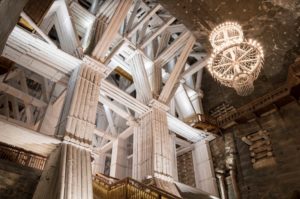If a two-hour walk along the dark, underground passages of a salt mine seems like a strange tourist attraction, think again. A stroll through the Wieliczka Salt Mine is nothing short of an exciting journey through crystal chambers and labyrinthine passages that seem to lead straight to the centre of the Earth. Along the way you will encounter unique salt monuments, lakes, and even entire churches hidden more than 65 meters below the surface. If you are not into sightseeing, then in Wieliczka you can always stop for a drink or have a pleasant meal in a nearby restaurant.

Other than the temperature, the Wieliczka mine surprises with its unparalleled set of beautifully decorated chambers (particularly worth seeing are the Copernicus Chamber and the Piłsudski Chamber), as well as the exhibits outlining the development of salt mining techniques since the Middle Ages. However, the most exciting attraction is the Blessed Kinga’s Chapel, which you will find right at the bottom of the mine. This one-of-a-kind 19th century church is carved solely out of crystalline salt, including the holy figurines and chandeliers that light the chamber with a warm glow. Though not easily accessible, every Sunday the chapel hosts a traditional catholic mass, and occasional jazz and classical music concerts performed by local and international musicians.
At Wieliczka be prepared for quite a walk. The mine comprises some 2,040 caverns of various sizes laid out on 9 levels, the top level about 65 meters below the surface and the lowest as deep as 135 meters. The path leading through the numerous chambers and along lakesides is about 2 miles long, just a fraction of the unbelievable 300 km of known passages that make up the mine. That’s why the tours offered at the Wieliczka Salt Mine usually last from two to three hours.
The Wieliczka Salt Mine is in the Lesser Poland Voivodship, some fifty kilometres south-east of Cracow. Located beneath a small and rather industrialised village, also called Wieliczka, the salt mine descends to about 135 meters below the surface, with its numerous passages, underground lakes and chambers carved from huge blocks of crystalline salt. The areas surrounding the mine are typical for the region – rolling hills, thick forests and occasional streams. You can get to Wieliczka most easily by one of the minibuses that run from Cracow’s main train station. You can also go by train, which will take you the village station located about 15 minutes away from the mine.
The history of the Wieliczka Salt Mine dates back to the 10th century, which makes it the second oldest mine in Poland (the oldest is the Bochnia mine located some 25 km from Wieliczka). The first records of Wieliczka date back to the 11th and 12th centuries, when it was officially recognized by the Polish king, Bolesław the Brave (995 – 1025). Almost from that moment the Wieliczka Salt Mine became the main economic foundation of the area. This should come as no surprise, considering the fact that in the Middle Ages salt was as valuable an ore as gold or silver due to its necessity in the production of arms and for preservation of meat and diary products.
Even though Wieliczka provided unbelievable amounts of salt (in the 14th century it accounted for nearly 25% of the state’s income), the excavation process was extremely expensive, mainly due to the rather primitive and time consuming techniques used by the miners. Hence, to avoid bankruptcy, the king was forced to resort to the services of private investors. However, the management over the mine remained strictly in the hands of the Royal Family. Later on, Polish kings freely used Wieliczka salt to pay off their debts or to trade with neighbouring countries. Some of the money was invested into more notable enterprises, such as the creation of the Kraków Academy and the restoration of the Wawel Castle.
The Wieliczka Salt Mine reached its peak of profitability in the 16th century. As one of the biggest enterprises in Europe, Wieliczka provided employment for hundreds of locals, who worked not only as miners or wagon drivers but also as carpenters, smiths, stable boys and even butlers. The rather surprising variety of professions was partly due to the mine becoming recognized as a heath centre, and hence a popular destination for the local aristocrats. Wieliczka soon saw the appearance of its first inns, baths, and restaurants serving traditional Polish cuisine.
In the 18th and 19th century it was decided that the mine should be transformed into a full-blown health resort, complete with ornate chambers, brine baths and the 17th century underground Chapel of St. Anthony. The year 1826 saw Wieliczka began to be officially referred to as a health centre, particularly recommended for patients with asthma and allergies. One of the early advocates of Wieliczka’s curative properties was Mieczysław Skulimowski, who discovered that Wieliczka’s unique microclimate helped to cure inflammation of the respiratory tracts.
In the 19th century Wieliczka became such a popular tourist destination that a special tourist route had to be created to cater the growing demands of the visitors. Unfortunately, this and frequent flooding caused great damage to the fragile construction of the mine. At the end of the 1950s the condition of the corridors and chapels was so alarming that the tours had to be cancelled. After a painstaking renovation process lasting nearly two decades the mine was reopened and today it welcomes thousands of visitors every month. In 1978 Wieliczka was added to the UNESCO World Cultural Heritage List.